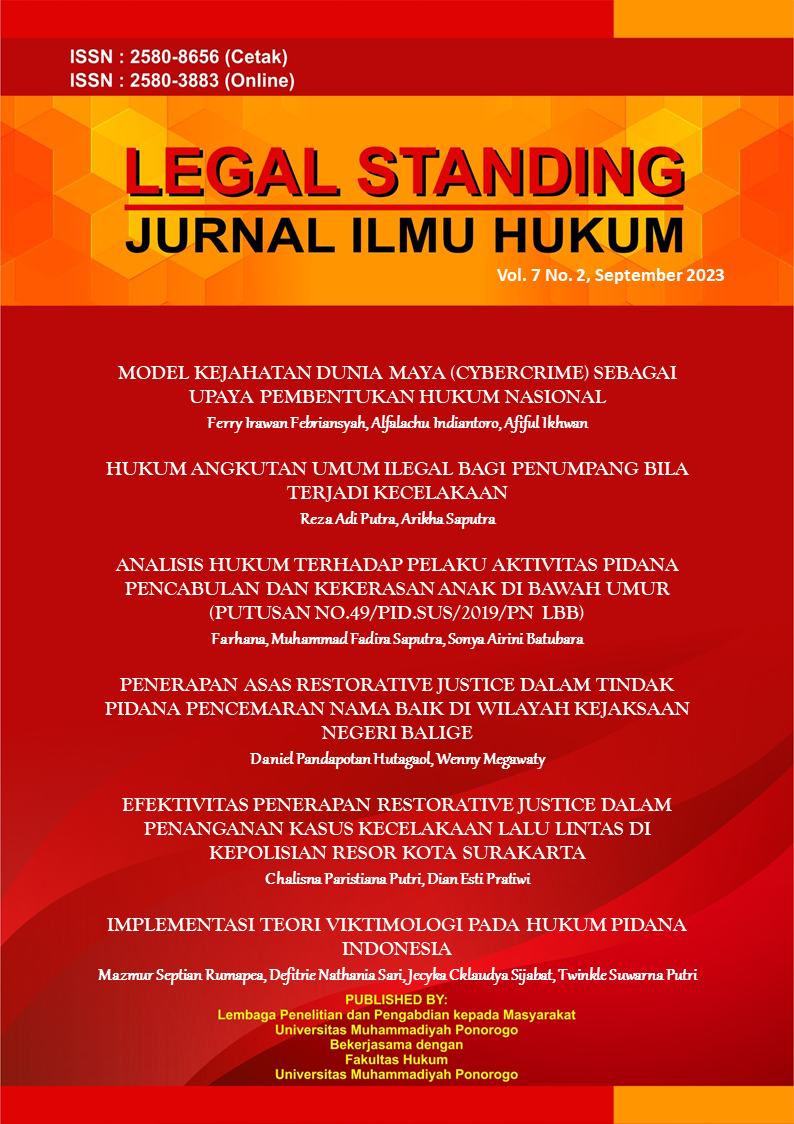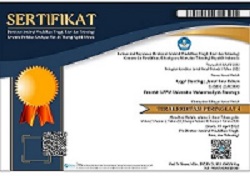HUKUM ANGKUTAN UMUM ILEGAL BAGI PENUMPANG BILA TERJADI KECELAKAAN
DOI:
https://doi.org/10.24269/ls.v7i2.5579Abstract
ABSTRACT
Transportation has now become a basic human need in fulfilling its mobility. The government is trying to make this happen by building mass public transportation such as bus rapid transit or BRT, city transportation and online-based transportation. However, it seems that it is still unable to meet the needs of various communities so that illegal public transportation or dark travel with private vehicles with black plates does not meet the requirements for public transportation, so that if an accident occurs it will be weak in the field of legal regulations as stipulated in Law Number 22 of 2009 concerning Traffic and road transport. The author conducted research using normative juridical methods guided by applicable laws and regulations, as well as using analytical descriptive methods to find out and understand the object of study. Illegal public transportation or dark travel operates without a permit to transport passengers without life insurance protection and does not pay mandatory fees as stipulated in Law Number 33 of 1964 concerning Passenger Accident Compulsory Insurance Funds, so that if an accident occurs the legal consequences are weak because they will not receive compensation. loss, if the passenger dies or suffers permanent disability. The government is responsible for organizing public transportation in an effort to meet the need for safe, secure, comfortable and affordable transportation. So public transportation must be in the form of a company that is licensed, legal entity and is required to pay mandatory contributions for life insurance for passengers, if an accident occurs they will receive compensation. Public transportation is illegal if in the event of an accident it will not get compensation due to death and permanent disability, because it does not pay mandatory coverage. As a result, passengers only receive compensation from the vehicle owner.
References
Benuf, K., & Azhar, M. (2020). Metodologi Penelitian Hukum sebagai Instrumen Mengurai Permasalahan Hukum Kontemporer. Gema Keadilan, 7(1), 20–33. https://doi.org/https://doi.org/10.14710/gk.2020.7504
Dishub. (2022). Wawancara Pegawai Dinas Perhubungan Provinsi Jawa Tengah Bidang Angkutan Jalan dan Wakil Ketua DPD Organda Provinsi Jawa Tengah. Jawa Tengah.
Guo, Z., Xiao, G., Wang, Y., Li, S., Du, J., Dai, B., … Xiao, D. (2023). Dynamic Model of Respiratory Infectious Disease Transmission in Urban Public Transportation Systems. Heliyon, 9(3), e14500. https://doi.org/10.1016/J.HELIYON.2023.E14500
KUHD. Kitab Undang - Undang Hukum Dagang- Pasal 246 (1938).
Maria, A. (2019). Aspek Hukum Transportasi Berbasis Aplikasi Dalam Perspektif Hukum Indonesia. Jurnal Bina Mulia Hukum, 3(2).
PM No.117. Peraturan Menteri Nomor 117 Tahun 2018 Tentang Penyelenggaraan Angkutan (2018).
PM No.44. Peraturan Pemerintah Nomor 44 Tahun 1993 Tentang Kendaraan dan Pengemudi (1993).
PM No.74. Peraturan Pemerintah RI Nomor 74 Tahun 2014 Tentang Angkutan Jalan (2014).
Reynardi, A. (2021). Penegakan Hukum Pidana Terhadap Pelanggaran Alih Fungsi Oleh Pemilik Kendaraan Pribadi Roda Empat Menjadi Angkutan Umum Ilegal Antar Kota Di Kota Pontianak. Jurnal Fatwa Hukum, 4(4).
Sadik-Zada, E. R., Santibanez Gonzalez, E. D., Gatto, A., Althaus, T., & Quliyev, F. (2023). Pathways to the Hydrogen Mobility Futures in German Public Transportation: A Scenario Analysis. Renewable Energy, 205, 384–392. https://doi.org/10.1016/J.RENENE.2022.12.087
Sudiro, & Roychansyah, M. S. (2019). Fenomena Angkutan Informal Perkotaan (Taksi Gelap) Studi Kasus Jalur Kota Manado – Kota Tomohon. Proceeding SENDI_U, 686–691. Retrieved from https://unisbank.ac.id/ojs/index.php/sendi_u/article/view/7319
Sumolang, I. K. (2017). Kajian Yuridis Terhadap Bisnis Transportasi Jalan Online Ditinjau Dari Berbagai Aspek Hukum Di Indonesia. Lex Administratum, 5(1).
UU No. 34. Undang - Undang Nomor 34 Tahun 1964 Tentang Dana Kecelakaan Lalu Lintas Jalan Jo Peraturan Pemerintan Nomor 18 Tahun 1965 (1964).
UU No.22. Undang - Undang Nomor 22 Tahun 2009 Tentang Lalu Lintas dan Angkutan Jalan (2009).
UU No.33. Undang – Undang Nomor 33 Tahun 1964 Tentang Dana Pertanggungan Wajib Kecelakaan Penumpang Jo Peraturan Pemerintah Nomor 17 Tahun 1965 (1964).
Xiao, G., Xiao, Y., Ni, A., Zhang, C., & Zong, F. (2022). Exploring Influence Mechanism of Bikesharing on the Use of Public Transportation — a Case of Shanghai. Transportation Letters. https://doi.org/10.1080/19427867.2022.2093287
Downloads
Published
How to Cite
Issue
Section
License

Legal Standing : (Jurnal Ilmu Hukum) is licensed under a Lisensi Creative Commons Atribusi-BerbagiSerupa 4.0 Internasional.

.png)

